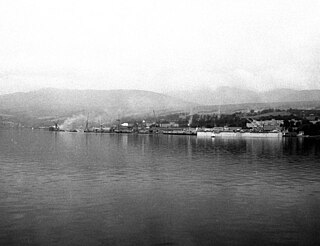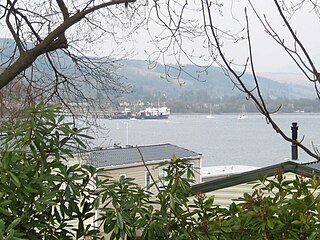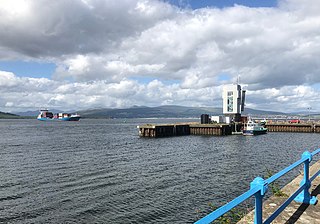
Argyll and Bute is one of 32 unitary council areas in Scotland and a lieutenancy area. The current lord-lieutenant for Argyll and Bute is Jane Margaret MacLeod. The administrative centre for the council area is in Lochgilphead at Kilmory Castle, a 19th-century Gothic Revival building and estate. The current council leader is Robin Currie, a councillor for Kintyre and the Islands.

Dunbartonshire or the County of Dumbarton is a historic county, lieutenancy area and registration county in the west central Lowlands of Scotland lying to the north of the River Clyde. Dunbartonshire borders Perthshire to the north, Stirlingshire to the east, Lanarkshire and Renfrewshire to the south, and Argyllshire to the west.

Helensburgh is a coastal town on the north side of the Firth of Clyde in Scotland, situated at the mouth of the Gareloch. Historically in Dunbartonshire, it became part of Argyll and Bute council area following local government reorganisation in 1996.

Faslane on Gare Loch is the name of a bay near the village of Garelochhead, and is now the main part of HM Naval Base Clyde in Argyll and Bute, Scotland, as well as being a Defence Logistics Organisation port, operated in dual site organisation with Great Harbour, Greenock, by Serco Denholm.

The Holy Loch is a sea loch, a part of the Cowal peninsula coast of the Firth of Clyde, in Argyll and Bute, Scotland.

Loch Long is a body of water in the council area of Argyll and Bute, Scotland. The Sea Loch extends from the Firth of Clyde at its southwestern end. It measures approximately 20 miles in length, with a width of between one and two miles. The loch also has an arm, Loch Goil, on its western side.

His Majesty's Naval Base, Clyde, primarily sited at Faslane on the Gare Loch, is one of three operating bases in the United Kingdom for the Royal Navy. It is the navy's headquarters in Scotland and is best known as the home of Britain's nuclear weapons, in the form of nuclear submarines armed with Trident missiles.

Rosneath is a village in Argyll and Bute, Scotland. It sits on the western shore of the Gare Loch, 2 miles northwest of the tip of the Rosneath Peninsula. It is about 2.4 miles by road from the village of Kilcreggan, which is sited on the southern shore of the peninsula, on the Firth of Clyde.

The Tail of the Bank is the name given to the anchorage in the upper Firth of Clyde immediately North of Greenock, between Inverclyde and Argyll and Bute. This area of the Firth gets its name from the deep water immediately to the west of the sandbank which marks the entrance to the navigable channel up the Estuary of the River Clyde.

Garelochhead railway station is a railway station serving the village of Garelochhead, on the Gare Loch, in Scotland. This station is on the West Highland Line and is a boundary station for SPT. It is sited 8 miles 76 chains (14.4 km) from Craigendoran Junction, near Helensburgh, between Arrochar and Tarbet and Helensburgh Upper. ScotRail manage the station and operate most services, with others provided by Caledonian Sleeper.

Garelochhead is a small town on the Gare Loch in Argyll and Bute, Scotland. It is the nearest town to the HMNB Clyde naval base.

Rhu is a village and historic parish on the east shore of the Gare Loch in Argyll and Bute, Scotland.
The West Loch Lomond Cycle Path is a cycle path that runs from Arrochar and Tarbet railway station, at the upper end of Loch Lomond in Scotland, to Balloch railway station, at the bottom of the loch. It was officially opened on 20 June 2006 by Tavish Scott.

Royal Naval Armaments Depot Coulport, shortened to RNAD Coulport, on Loch Long in Argyll, Scotland, is the storage and loading facility for the nuclear warheads of the United Kingdom's Trident programme.

Shandon is an affluent settlement of houses forming a village on the open sea loch of the Gare Loch in Argyll and Bute, Scotland. Shandon overlooks the Rosneath Peninsula to the west and is bordered by Glen Fruin to the east, which is the site of the Battle of Glen Fruin, one of the last clan battles in Scotland, fought on 7 February 1603, in which an estimated 300 warriors on foot from the MacGregor Clan claimed victory over an estimated 600–800 men from the Colquhoun Clan on horse-back.

Faslane Castle and Shandon Castle were two mediaeval Scottish castles which once stood between the village of Garelochhead and the town of Helensburgh, near the shores of the Gareloch, in Argyll and Bute. In the 19th century, the castles were thought to have dated back to the Middle Ages. At that time period, they were situated in within the mormaerdom of Lennox, which was controlled by the mormaers of Lennox. Today nothing remains of Faslane Castle; though in the 19th century certain ruins of Shandon Castle were said to have still existed. Near the site of Faslane Castle sits the ruinous St Michael's Chapel, which has also been thought to date to the Middle Ages.
Clynder is a place on the western shore of the Gare Loch, Argyll and Bute, Scotland.

Finnart Oil Terminal, also known as Finnart Ocean Terminal or Chap Point, is an oil depot on the eastern shore of Loch Long, Firth of Clyde on the west coast of Scotland, about 2 miles (3.2 km) to the north of Garelochhead on the A814 road to Arrochar. It has piers extending a short distance into the loch, providing a deep water berth for oil tankers up to 324,000 tonnes. Two pipelines connect the terminal across the width of Scotland to the Grangemouth Refinery on the Firth of Forth on the east coast, and extensive oil storage tanks have been built into the hillside on both sides of the main road.

The Rosneath Peninsula is a peninsula in Argyll and Bute, western Scotland. Formerly in the historic county of Dunbartonshire, it is formed on its eastern shore from the confluence of the Firth of Clyde with the Gare Loch, and of the Clyde with Loch Long to the west.


















